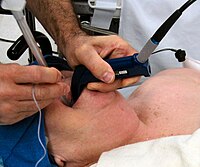
Photo from wikipedia
Although not as exceptional as 2020, last year remained subjugated by the COVID-19 pandemic. One of the tiniest of all living creatures, a virus, was and is still keeping humanity… Click to show full abstract
Although not as exceptional as 2020, last year remained subjugated by the COVID-19 pandemic. One of the tiniest of all living creatures, a virus, was and is still keeping humanity under its thumb. National Geographic estimated there are a mind-boggling 10 nonillion (10 to the 31st power) individual viruses that exist on our planet—enough to assign one to every star in the universe 100 million times over [1]. Reason enough to believe that this pandemic will not be the last of our generation. A matter to deal with on another occasion. The pandemic elucidated this virus can attack anyone, irrespective of race, gender, function, or status. Although sickness and death have no bias, one could argue that access to care and health disparities would put a toll on outcomes and safety. News from friends or colleagues succumbing to the disease, affected us deeply: to add to the tragedy, burnout and depression have doubled the burdens. While science and research endeavours were significantly hampered, apart from SARS-CoV-2 related research, anaesthesiology was positively impacted by COVID-19. In particular, modifications in airway management with the purposes of protecting both patients and healthcare workers, sprouted clinical and technological research. Diving further into academia, several papers have been published considering the impact of COVID-19 on airway management since it is one of the highest risk procedures for aerosol and droplet dispersion. The emphasis hereby lies on using adequate personal protective equipment to reduce exposure risk to providers and minimalizing aerosolization [2–6]. To accomplish the latter, endotracheal intubation should be performed after preoxygenation with a tight-fitting facemask applied with a two-handed “vice grip” in a spontaneously breathing patient [3–5]. A HEPA filter should be attached directly to any airway adjuncts and especially the airway outlet of a ventilator to prevent the potential spread of infectious respiratory droplets [2–5]. Judicious use of neuromuscular blocking agents (NMBA) is recommended to ensure adequate paralysis [2, 4, 5]. The optimal method for apnoeic oxygenation remains unclear. It has been suggested that nasal oxygen therapy or non-rebreather (NRB) masks increase the risk of aerosolizing viral particles [2, 3, 5]: authors seem divided in those advising to place a surgical mask over the nasal cannula or the NRB [2], while others advise against the use of nasal oxygen therapy or NRB for apnoeic oxygenation altogether [3, 5] and recommend bag-mask ventilation once hypoxemia is present or imminent [3, 4]. Extubation strategies should be carefully premeditated aiming to attenuate emergenceresponse of airway irritation and agitation by considering the use of antitussive medication [3–5]. Due to the COVID-19 pandemic, patients are increasingly ventilated during anaesthesia and in the ICU for a longer duration, hence adequate pressure in the endotracheal tube (ETT) cuff is of paramount importance. Both over-inflation, as well as under-inflation, are associated with clinically significant complications [7] and insufficient inflation pressure could lead to leaks and the risk of aerosolization [4, 5]. Intracuff pressure should be aimed to be between 40 and 60 cm H2O to create an adequate seal around the patient’s glottic entrance and should be checked whenever feasible, possibly three times daily [7]. As we approach a sustainable practice and become sensible to our carbon footprint, the use of disposable and * Tom C. R. V. Van Zundert [email protected]
Journal Title: Journal of Clinical Monitoring and Computing
Year Published: 2022
Link to full text (if available)
Share on Social Media: Sign Up to like & get
recommendations!